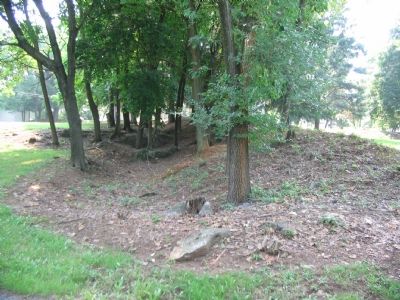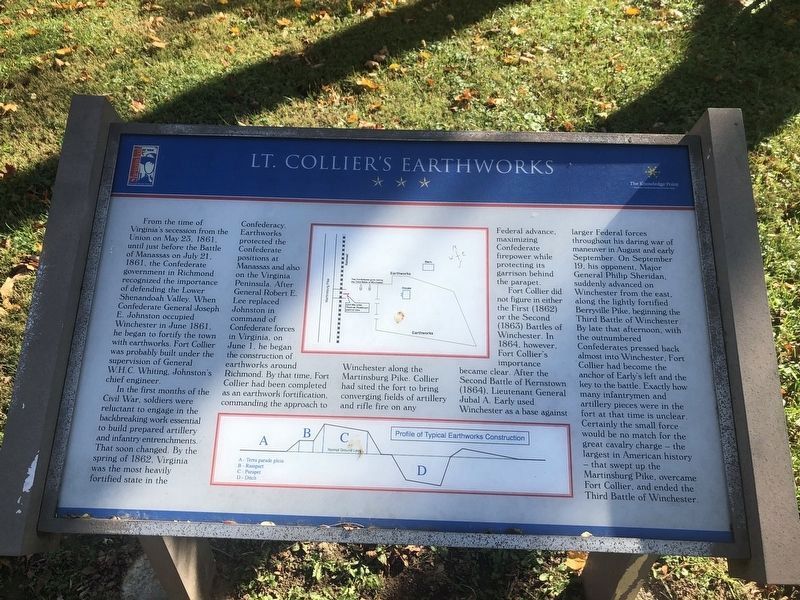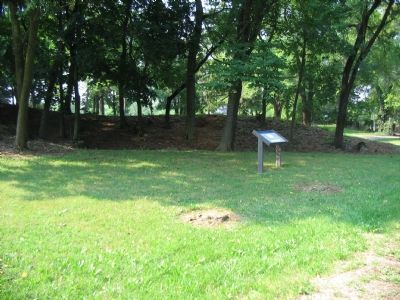Near Winchester in Frederick County, Virginia — The American South (Mid-Atlantic)
Lt. Collierís Earthworks
From the time of Virginiaís secession from the Union on May 23, 1861, until just before the Battle of Manassas on July 21, 1861, the Confederate government in Richmond recognized the importance of defending the Lower Shenandoah Valley. When Confederate General Joseph E. Johnston occupied Winchester in June, 1861, he began to fortify the town with earthworks. Fort Collier was probably built under the supervision of General W.H.C. Whiting, Johnstonís chief engineer.
In the first months of the Civil War, soldiers were reluctant to engage in the backbreaking work essential to build prepared artillery and infantry entrenchments. That soon changed. By the spring of 1862, Virginia was the most heavily fortified state in the Confederacy. Earthworks protected the Confederate positions at Manssas and also along the Virginia Peninsula. After General Robert E. Lee Replaced Johnston in command of Confederate forces in Virginia, on June 1, he began the construction of earthworks around Richmond. By that time, Fort Collier had been completed as an earthwork fortification, commanding the approach to Winchester along the Martinsburg Pike. Collier had sited the fort to bring converging fields of artillery and rife fire on any Federal advance, maximizing Confederate firepower while protecting the garrison behind the parapet.
Fort collier did not figure in either the First (1862) or the Second (1863 Battles of Winchester. In 1864, however, Fort Collierís importance became clear. After the Second Battle of Kernstown (1864), Lieutenant General Jubal A. Early used Winchester as a base against larger Federal forces throughout his daring war of maneuver in August and early September. On September 19, his opponent, Major General Philip Sheridan, suddenly advanced on Winchester from the east, along the lightly fortified Berryville Pike, beginning the Third Battle of Winchester. By late that afternoon, with the outnumbered Confederates pressed back almost into Winchester, Fort Collier had become the anchor of Earlyís left and the key to the battle. Exactly how many infantrymen and artillery pieces were in the fort at the time is unclear. Certainly the small force would be no match for the great cavalry chargeóthe largest in American historyóthat swept up the Martinsburg Pike, overcame Fort Collier, and ended the Third Battle of Winchester.
Erected by Shenandoah at War / The Knowledge Point.
Topics. This historical marker is listed in this topic list: War, US Civil. A significant historical month for this entry is May 1968.
Location. 39° 12.117′ N, 78° 9.241′ W. Marker is near Winchester, Virginia, in Frederick County. Marker can be reached from the
intersection of Martinsburg Pike (U.S. 11) and Brooke Road (County Route 1322), on the right when traveling north. Located on the north side of the walking loop around Fort Collier, in the Fort Collier Civil War Center. Touch for map. Marker is at or near this postal address: 922 Martinsburg Pike, Winchester VA 22601, United States of America. Touch for directions.
Other nearby markers. At least 8 other markers are within walking distance of this marker. Fort Collier (within shouting distance of this marker); a different marker also named Fort Collier (within shouting distance of this marker); The Cavalry Charge at Fort Collier (within shouting distance of this marker); a different marker also named Fort Collier (about 300 feet away, measured in a direct line); George Washington in Winchester (about 300 feet away); Third Battle of Winchester (about 400 feet away); 2nd Battle of Winchester / 3rd Battle of Winchester (about 600 feet away); 2nd Battle of Winchester (about 600 feet away). Touch for a list and map of all markers in Winchester.
More about this marker. Drawings on the marker detail the layout of the fort and the profile of the earthworks.
Regarding Lt. Collierís Earthworks. The related markers section links the Civil War Trails marker and the four interpretive markers located at the Fort Collier Civil War Center.
Related markers. Click here

Photographed By Craig Swain, August 25, 2007
3. The Earthworks in Profile
To compare to the diagram, the ditch is directly in the center, with the parapet rising on the right. In front of the ditch (on the left of this photo) is a glacis slope. The glacis here is worn down somewhat, but served to re-direct enemy artillery projectiles, up and over the fortification.
Also see . . . Fort Collier Civil War Center. Website homepage (Submitted on September 13, 2007, by Craig Swain of Leesburg, Virginia.)
Credits. This page was last revised on January 7, 2023. It was originally submitted on September 13, 2007, by Craig Swain of Leesburg, Virginia. This page has been viewed 1,729 times since then and 22 times this year. Last updated on February 19, 2022, by Bradley Owen of Morgantown, West Virginia. Photos: 1. submitted on November 7, 2020, by Devry Becker Jones of Washington, District of Columbia. 2, 3. submitted on September 13, 2007, by Craig Swain of Leesburg, Virginia. • J. Makali Bruton was the editor who published this page.

